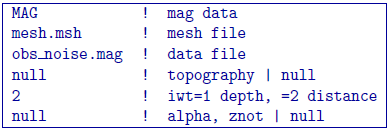4.2.2. PFWEIGHT¶
This program performs the depth weighting function calculation. This allows users the flexibility to either use this code or their in-house code for the weighting calculation. Command line usage:
pfweight weights.inp [nThreads]
For a sample input file type:
pfweight -inp
The argument specifying the number of CPU threads used in the OpenMP format is optional. If this argument is not given to the program, chooses to use all of the CPU threads on the machine. This argument allows the user to specify half, for example, of the threads so that the program does not take all available RAM. Note that this option is not available in the MPI-based code used for clusters.
4.2.2.1. Input files¶
Format of the control file:

The input parameters for the control file are:
type: UseMAGto havepfweightread magnetic location files.mesh.msh: Name of 3D mesh file.obs.grvThe data file that contains the observation locations and the observed magnetic anomaly with estimated standard deviation.topo.dat: Surface topography file. Ifnullis entered, the surface will be treated as being flat on the top of the mesh.iwt: An integer (1or2) identifying the type of generalized depth weighting to use in the inversion.- =1 for depth weighting (not applicable to borehole data);=2 for distance weighting.
alpha,znot: Parameters defining the depth weighting function:- NOTE 1: If
nullis entered on this line (line 6), then the program setsalpha=2and calculates the value of \(z_o\) based upon the mesh and data location. This is true foriwt=1oriwt=2NOTE 2: For most inversions, setting this input line tonullis recommended. The option for inputing \(\alpha\) and \(z_o\) is provided for experienced users who would like to investigate the effect of the generalized depth weighting for special purposes. The value of \(\alpha\) should normally be close to 2.0. Smaller values of give rise to weaker weighting as distance increases from the observation locations.
4.2.2.1.1. Example of input file¶

4.2.2.2. Output files¶
The program outputs x_weight.txt. A file in the format, which contains weights for each cell, based on depth weighting (x = “depth”) or distance weighting (x = “distance”). A log file pfweight.log is also written.